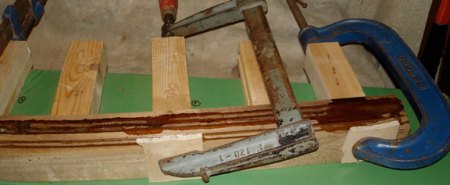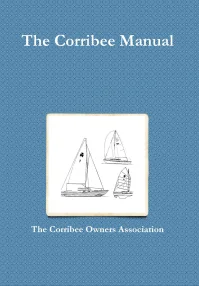Mast beam
The mast beam on a Corribee can fail for a couple of reasons. Over-tensioned rigging can exert enough downward force to cause it to break away from the underside of the coach roof, onto which it is bonded with a few layers of chopped strand mat. Water can enter through the mast step fitting causing it to rot, and the weakened beam will then break in the middle.
It is very easy to miss the early signs of mast beam failure – all the internal symptoms are hidden by headlining material and other cosmetic details. Externally, it is difficult to know whether the mast step is securely fitted without removing the mast – the step fitting should be bedded with a compound such as Sikaflex, but this is the sort of fitting that may not have been touched for many years and, in any case, may not have been fitted with a suitable sealant in the first place.
The symptoms:
On this Corribee (Katie Miller’s Elektra) the port side of the coachroof is dished – look at the angle of the ventilator cover.
Below, a closer look shows where water has puddled (between the ventilator and the forehatch).
Looking inside, the problem is obvious – the grp laminate bonding the beam in place has failed, allowing the downward load of the mast deform the coachroof. (Thanks to Katie Miller for these three photos of Elektra).
The only immediately visible clue (below) on this Corribee (Clareen, sail no 599) was a slight dishing of the mast step moulding, shown here by the small 2mm gap under the steel rule.
The other indication, hidden under the headlining and not at all obvious, was that the beam had fractured inside the grp. It is just visible as a very faint lighter coloured vertical line (arrowed) right in the centre of the beam. It doesn’t look much, but after removal it was clearly in a much worse condition than is apparent here (see further down).
This first step may not be necessary in every case, but if the mast step has developed a dish shape it may need removing. A Fein Multicut will remove it neatly – for use as the basis of a mould for a new one, or some remedial work before rebonding it in place.
Underneath is the plywood backing plate which sits on top of the mast beam. Water penetration through the fixings of the mast step are the obvious cause of this problem. Unless the beam is in perfect condition it has to be removed and replaced.
Repairs:
The grp which encapsulates the beam has to be cut. A Fein Multicut, a Dremel fitted with a mini cutting disc or a mallet and wood chisel can be used. An angle grinder is a possible but messy option. Whichever method is chosen you will need a vacuum cleaner.
After cutting the grp, this beam was removed in sections with a mallet and chisel. There is evidence of water penetration even at the end of the beam. It is also apparent that the beam has been made from pieces of ply, not a particularly good example of boatbuilding joinery.
Sawing the beam into sections made it easier to remove cleanly. This Corribee has a bulkhead which made the work a bit more time consuming.
After removal, the hairline crack in the centre section of the beam has given way completely. Any doubts about the necessity of this work have now gone!
Renewal:
After removing the old beam it is best to make a template from stiff card, assuming that the deckhead is still in good shape. If it isn’t, and the old beam has not broken it may be possible to use that as a guide. Failing that you’ll have to find another Corribee, but bear in mind that the superstructure moulding was changed over the years, so find a comparable model to copy.
A piece of 18mm chipboard and some short lengths of 50mm sq softwood are used to make a simple former on which to fabricate the new beam. This is made up with lengths of 60 x 10mm thick laminates, in this case iroko. Hardwood is preferable for strength – oak or mahogany are suitable alternatives, or teak if you can afford it. A good quality softwood, close-grained and knot-free, will probably be ok, but you may wish to make the beam a bit deeper in section to compensate for the slightly lower strength. The beam shown here has a finished depth of 70mm.
Make sure that the laminating former is soundly constructed as it will have to withstand quite a load when the laminates are clamped in place. The 50mm sq blocks are glued and screwed to the base board. The green polythene is necessary to prevent the beam sticking to the jig.
The laminates are bonded with SP Systems SP106 epoxy resin, thickened with microfibres. This will need to cure for 12 hours at at least 15C before the cramps are released. There will probably be a small amount of springback – about 3mm in this case – so check the beam against the template after the glueing process. It may be necessary to modify the profile slightly to ensure a good fit. It will be bonded into place with a thickened epoxy mix, which is able to fill small gaps up to around 3mm, so it shouldn’t be too difficult to get a decent fit.
A bandsaw is used to clean up the side faces of the beam. Despite taking care when clamping it is very difficult to make sure that the edges of the laminates stay in line, so it is necessary to remove a couple of mm. This can also be done with a sharp smoothing plane.
A smoothing plane is used to finish of the sides. The top and bottom edges don’t need finishing.
Radius the two bottom corners with a spokeshave – it will be laminated in place with epoxy and glass cloth, which won’t bend round a sharp corner.
Replacement:
With the old beam removed, the grp needs to be cleaned up. A Dremel fitted with a rotary sanding drum is quite useful as it can be held with one hand, the other hand holding a vacuum cleaner nozzle close to the action to remove the dust. A 50mm wide strip each side of the beam will allow a large enough area to be bonded with glass cloth and epoxy. The photo below shows the beam in position – a dry run before glueing. A small clearance between the top of the bulkhead and the underside of the beam is really unavoidable, partly to ensure that the top of the beam can be properly bonded to the underside of the coachroof.
Apply a generous thickness of thickened epoxy resin to the top surface of the beam and slot into position. A couple of props are then hammered into position to force the beam upwards – have a disposable paint brush handy to wipe the excess epoxy along the joint as it is squeezed out, helping to fill any gaps and form a fillet along the top edge.
At this stage it can be left to cure – leave the props in place as long as possible, at least 24 hours. In this case strengthening knees have been added to the bulkhead on each side – epoxied to the bulkhead and to the surrounding grp moulding. The cramp has been used to keep the bulkhead in line with the new mast beam.
Nearly finished – strips of 600 g/sq m woven glass cloth are epoxied along all the joints – 2 or 3 layers are sufficient The resultant beam is certainly much stronger than the original plywood version, and the mast load will be spread over a much wider area. It would be wise to check that the bulkhead is bonded securely to the hull around the lower edges – if there is any doubt it is a relatively simple job to reinforce the bonding with more epoxy and glass cloth.
With a laminated beam such as this one there is no need to encapsulate it with epoxy/glass. It is strong enough as it is, and if, in future, there is a problem with water penetration through the mast step there’s a chance you will spot it early, rather than too late.
The last stage is to bond the mast step back in place (if you initially removed it, as in this example). The raised step means that there is a 12-15mm gap between the top surface of the beam and the underside of the grp, which must be filled. Provided you use plenty of epoxy, a square of marine plywood is ok – check the thickness so you can be certain that it sits firmly on top of the mast beam.
This mast step needed some major surgery as the top surface had deformed. It was built up to the correct shape with glass cloth and epoxy filler and bedded down onto the top of the beam with more thickened epoxy.
The saw cut (from when it was originally removed) was filled and the area then sprayed – a can of white spray paint from a car accessory shop.
The aluminium mast step fitting has been cleaned up and resprayed with etch primer and silver lacquer – see the Roller Reefing page for details, links at top of page. This is refitted on a bed of Sikaflex. M6 csk machine screws were used for the two end holes, and 50mm x 12 gauge A4 self tappers for the centre two holes which screw directly into the mast beam.
You may want to take some time over this, as it was the original cause of the problem. It is worth pre-drilling all the holes slightly oversize so you can seal the internal surface with epoxy resin – use it without any thickening additives and apply to the cut surface with a small brush or something like a cocktail stick.
Source: corribee.org
An alternative mast beam fix..
Guy Waites shows an alternative mast beam replacement on his blog – a core of foam to dictate the shape and dimensions, laminated with carbon-fibre cloth. Have a look at the 2013 page for details and photos.
Contribute
Do you have a story, information, brochure, manual, link or other relevant content that should be on this page? If so, we would be very grateful if you would leave it as a comment or email corribeeeditors@googlemail.com so we can post here – thanks!

























Leave a comment